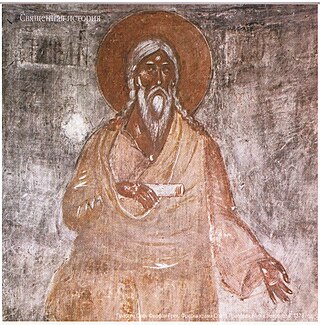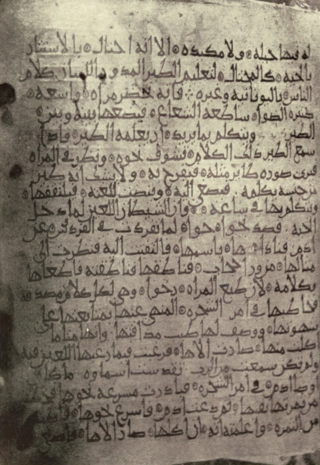Related Research Articles

Seth, in the Abrahamic religions, was the third son of Adam and Eve. According to the Hebrew Bible, he had two brothers: Cain and Abel. According to Genesis 4:25, Seth was born after Abel's murder by Cain, and Eve believed that God had appointed him as a replacement for Abel.

Enoch is a biblical figure and patriarch prior to Noah's flood, and the son of Jared and father of Methuselah. He was of the Antediluvian period in the Hebrew Bible.

The Book of Jubilees, sometimes called Lesser Genesis or Leptogenesis, is an ancient Jewish apocryphal text of 50 chapters, considered canonical by the Ethiopian Orthodox Tewahedo Church as well as Beta Israel, where it is known as the Book of Division. Jubilees is considered one of the pseudepigrapha by the Eastern Orthodox, Catholic, and Protestant churches. Apart from the Beta Israel community, the book is not considered canonical within any of the denominations of Judaism.

The Book of Enoch is an ancient Hebrew apocalyptic religious text, ascribed by tradition to the patriarch Enoch who was the father of Methuselah and the great-grandfather of Noah. The Book of Enoch contains unique material on the origins of demons and Nephilim, why some angels fell from heaven, an explanation of why the Genesis flood was morally necessary, and a prophetic exposition of the thousand-year reign of the Messiah. Three books are traditionally attributed to Enoch, including the distinct works 2 Enoch and 3 Enoch.

Pseudepigrapha are falsely attributed works, texts whose claimed author is not the true author, or a work whose real author attributed it to a figure of the past. The name of the author to whom the work is falsely attributed is often prefixed with the particle "pseudo-", such as for example "pseudo-Aristotle" or "pseudo-Dionysius": these terms refer to the anonymous authors of works falsely attributed to Aristotle and Dionysius the Areopagite, respectively.
The Conflict of Adam and Eve with Satan is a 6th-century Christian extracanonical work found in Ge'ez, translated from an Arabic original.
The Life of Adam and Eve, also known in its Greek version as the Apocalypse of Moses, is a Jewish apocryphal group of writings. It recounts the lives of Adam and Eve from after their expulsion from the Garden of Eden to their deaths. It provides more detail about the Fall of Man, including Eve's version of the story. Satan explains that he rebelled when God commanded him to bow down to Adam. After Adam dies, he and all his descendants are promised a resurrection.
The Clementine literature is a late antique third-century Christiance romance or "novel" containing a fictitious account of the conversion of Clement of Rome to Christianity, his subsequent life and travels with the apostle Peter and an account of how they became traveling companions, Peter's discourses, and finally Clement's family history and eventual reunion with his family. To reflect the pseudonymous nature of the authorship, the author is sometimes referred to as Pseudo-Clement. In all likelihood, the original text went by the name of Periodoi Petrou or Circuits of Peter; sometimes historians refer to it as the "Basic Writing" or "Grundschrift".

The New Testament apocrypha are a number of writings by early Christians that give accounts of Jesus and his teachings, the nature of God, or the teachings of his apostles and of their lives. Some of these writings were cited as scripture by early Christians, but since the fifth century a widespread consensus has emerged limiting the New Testament to the 27 books of the modern canon. Roman Catholic, Eastern Orthodox, and Protestant churches generally do not view the New Testament apocrypha as part of the Bible.

Joseph and Asenath is a narrative that dates from between 200 BCE and 200 CE. It concerns the Hebrew patriarch Joseph and his marriage to Asenath, expanding the fleeting mentions of their relationship in the Book of Genesis. The text was translated widely, including into Amharic, Arabic, Armenian, Early Modern German, Latin, Middle English, Old French, Romanian, Serbian and Syriac.

The Ascension of Isaiah is a pseudepigraphical Judeo-Christian text. Scholarly estimates regarding the date of the Ascension of Isaiah range from 70 AD to 175 AD. Many scholars believe it to be a compilation of several texts completed by an unknown Christian scribe who claimed to be the Prophet Isaiah, while an increasing number of scholars in recent years have argued that the work is a unity by a single author that may have utilized multiple sources.
Yahoel is the name of an angel appearing in the Old Church Slavonic manuscripts of the Apocalypse of Abraham, a pseudepigraphical work dating from after the siege of Jerusalem (70). The name is thought to be a compound of the Tetragrammaton and ʔēl, the Hebrew word for 'God'. He is an associate of Michael charged to restrain Leviathan and destroy idolaters (10:10–14).
The Cave of Treasures, sometimes referred to simply as The Treasure, is an apocryphal and pseudoepigraphical work, that contains various narratives related to the Christian Bible. It was written in the Syriac language, approximately at the end of the 6th, or at the beginning of the 7th century. Its authorship was traditionally attributed to Ephrem of Edessa, but modern scholarly analyses have shown that the true author was some other person, who also lived in Upper Mesopotamia, but much later.
2 Baruch is a Jewish pseudepigraphical text thought to have been written in the late 1st century CE or early 2nd century CE, after the destruction of the Temple in CE 70. It is attributed to the biblical figure Baruch ben Neriah and so is associated with the Old Testament, but not regarded as scripture by Jews or by most Christian groups. It is included in some editions of the Peshitta, and is part of the Bible in the Syriac Orthodox tradition. It has 87 sections (chapters).

The Prayer of Joseph is a pseudepigraphic writing of the Old Testament. It was composed either in Aramaic or in Greek in the 1st century AD. The text is almost lost and only a few fragments have survived in ancient quotations concerning the Biblical patriarch Jacob. The Prayer of Joseph narrates that Jacob was the incarnation of the angel Israel who competed with Uriel over their rank in heaven.
Jewish magical papyri are a subclass of papyri with specific Jewish magical uses, and which shed light on popular belief during the late Second Temple Period and after in Late Antiquity. A related category of contemporary evidence are Jewish magical inscriptions, typically on amulets, ostraca, and incantation bowls.
In the Book of Enoch and Book of Jubilees, copies of which were kept by groups including the religious community of Qumran that produced the Dead Sea Scrolls, the Elioud are the antediluvian children of the Nephilim, and are considered a part-angel hybrid race of their own. Like the Nephilim, the Elioud are exceptional in both ability and wickedness.

The Apocalypse of Peter or Vision of Peter, also known as the Book of the Rolls and other titles, is an Arab Christian work probably written in the 10th century; the late 9th century and 11th century are also considered plausible. Around 40 manuscripts of it have been preserved and found. It is pseudepigraphically attributed to Clement of Rome, relating a vision experienced by the Apostle Peter of the resurrected Jesus; the actual author is unknown. The work was originally written in Arabic; many Ethiopic manuscripts exist as well, with the reworked Ethiopic version in the work Clement along with other stories of Clementine literature.
The Investiture of Abbaton, the Enthronement of Abbaton, or the Encomium on Abbaton, is an apocalyptic, pseudepigraphical, and apocryphal text. It describes the creation of Adam by God, Jesus, and the Holy Spirit; the fall of Satan; and the transformation of Muriel into Abbaton, the angel of death. The sole extant copy is dated to 981, and while its present version probably dates to the 700s, it may have an original from the 600s. It is purportedly written by Timothy of Alexandria.
References
- 1 2 3 4 5 6 7 Robinson, S. E. (1983). "Testament of Adam". In Charlesworth, James (ed.). The Old Testament Pseudepigrapha Volume 1. Translated by Robinson, S. E. Doubleday. pp. 989–995. ISBN 0-385-09630-5.